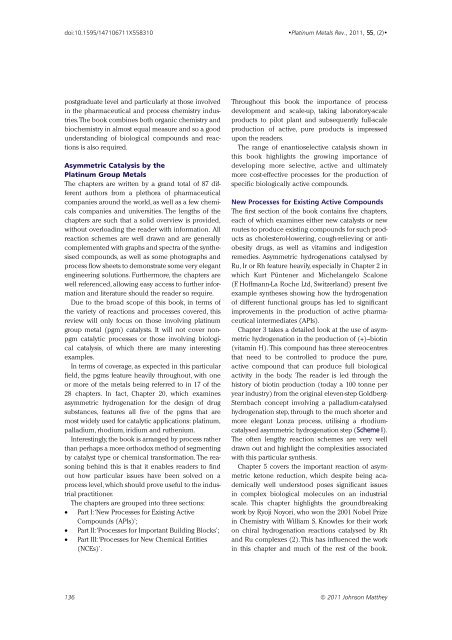Download - Platinum Metals Review
Download - Platinum Metals Review
Download - Platinum Metals Review
Create successful ePaper yourself
Turn your PDF publications into a flip-book with our unique Google optimized e-Paper software.
doi:10.1595/147106711X558310<br />
•<strong>Platinum</strong> <strong>Metals</strong> Rev., 2011, 55, (2)•<br />
postgraduate level and particularly at those involved<br />
in the pharmaceutical and process chemistry industries.The<br />
book combines both organic chemistry and<br />
biochemistry in almost equal measure and so a good<br />
understanding of biological compounds and reactions<br />
is also required.<br />
Asymmetric Catalysis by the<br />
<strong>Platinum</strong> Group <strong>Metals</strong><br />
The chapters are written by a grand total of 87 different<br />
authors from a plethora of pharmaceutical<br />
companies around the world, as well as a few chemicals<br />
companies and universities. The lengths of the<br />
chapters are such that a solid overview is provided,<br />
without overloading the reader with information. All<br />
reaction schemes are well drawn and are generally<br />
complemented with graphs and spectra of the synthesised<br />
compounds, as well as some photographs and<br />
process flow sheets to demonstrate some very elegant<br />
engineering solutions. Furthermore, the chapters are<br />
well referenced, allowing easy access to further information<br />
and literature should the reader so require.<br />
Due to the broad scope of this book, in terms of<br />
the variety of reactions and processes covered, this<br />
review will only focus on those involving platinum<br />
group metal (pgm) catalysts. It will not cover nonpgm<br />
catalytic processes or those involving biological<br />
catalysis, of which there are many interesting<br />
examples.<br />
In terms of coverage, as expected in this particular<br />
field, the pgms feature heavily throughout, with one<br />
or more of the metals being referred to in 17 of the<br />
28 chapters. In fact, Chapter 20, which examines<br />
asymmetric hydrogenation for the design of drug<br />
substances, features all five of the pgms that are<br />
most widely used for catalytic applications: platinum,<br />
palladium, rhodium, iridium and ruthenium.<br />
Interestingly, the book is arranged by process rather<br />
than perhaps a more orthodox method of segmenting<br />
by catalyst type or chemical transformation. The reasoning<br />
behind this is that it enables readers to find<br />
out how particular issues have been solved on a<br />
process level, which should prove useful to the industrial<br />
practitioner.<br />
The chapters are grouped into three sections:<br />
• Part I:‘New Processes for Existing Active<br />
Compounds (APIs)’;<br />
• Part II:‘Processes for Important Building Blocks’;<br />
• Part III:‘Processes for New Chemical Entities<br />
(NCEs)’.<br />
Throughout this book the importance of process<br />
development and scale-up, taking laboratory-scale<br />
products to pilot plant and subsequently full-scale<br />
production of active, pure products is impressed<br />
upon the readers.<br />
The range of enantioselective catalysis shown in<br />
this book highlights the growing importance of<br />
developing more selective, active and ultimately<br />
more cost-effective processes for the production of<br />
specific biologically active compounds.<br />
New Processes for Existing Active Compounds<br />
The first section of the book contains five chapters,<br />
each of which examines either new catalysts or new<br />
routes to produce existing compounds for such products<br />
as cholesterol-lowering, cough-relieving or antiobesity<br />
drugs, as well as vitamins and indigestion<br />
remedies. Asymmetric hydrogenations catalysed by<br />
Ru, Ir or Rh feature heavily, especially in Chapter 2 in<br />
which Kurt Püntener and Michelangelo Scalone<br />
(F. Hoffmann-La Roche Ltd, Switzerland) present five<br />
example syntheses showing how the hydrogenation<br />
of different functional groups has led to significant<br />
improvements in the production of active pharmaceutical<br />
intermediates (APIs).<br />
Chapter 3 takes a detailed look at the use of asymmetric<br />
hydrogenation in the production of (+)–biotin<br />
(vitamin H). This compound has three stereocentres<br />
that need to be controlled to produce the pure,<br />
active compound that can produce full biological<br />
activity in the body. The reader is led through the<br />
history of biotin production (today a 100 tonne per<br />
year industry) from the original eleven-step Goldberg-<br />
Sternbach concept involving a palladium-catalysed<br />
hydrogenation step, through to the much shorter and<br />
more elegant Lonza process, utilising a rhodiumcatalysed<br />
asymmetric hydrogenation step (Scheme I).<br />
The often lengthy reaction schemes are very well<br />
drawn out and highlight the complexities associated<br />
with this particular synthesis.<br />
Chapter 5 covers the important reaction of asymmetric<br />
ketone reduction, which despite being academically<br />
well understood poses significant issues<br />
in complex biological molecules on an industrial<br />
scale. This chapter highlights the groundbreaking<br />
work by Ryoji Noyori, who won the 2001 Nobel Prize<br />
in Chemistry with William S. Knowles for their work<br />
on chiral hydrogenation reactions catalysed by Rh<br />
and Ru complexes (2). This has influenced the work<br />
in this chapter and much of the rest of the book.<br />
136 © 2011 Johnson Matthey
















